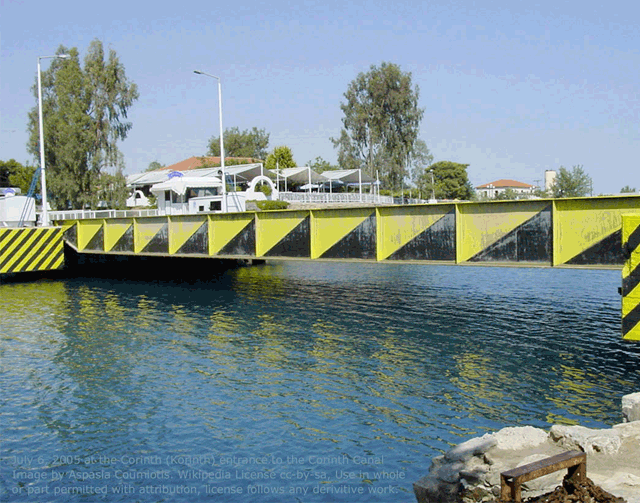Submersible bridge
|
This animated GIF was made from a series of photos of the submersible bridge at the Corinth (Korinth) entrance to the Corinth Canal. |
Contents |
[edit] Introduction
A bridge is a spanning structure that creates a passage over an obstacle such as a river, gorge, valley, road, railway and so on. A movable bridge (or moveable bridge) is a spanning structure that can change position (or even shape) to accommodate different situations, such as the requirements of ships, barges and other types of traffic above or below it. Some movable bridges can be inconvenient due to delays caused when one stream of traffic is halted to accommodate the passage of the other.
One type of movable bridge is a submersible or submergible bridge. These structures may also be referred to as ducking bridges. Low water bridges are also sometimes referred to as submersible bridges. However, this is generally an inaccuracy, since low water bridges tend to be fixed structures while submersible bridges are actively movable.
[edit] The purpose of submersible bridges
Submersible bridges are generally built low and close to the average water level. They are generally inexpensive and simple to build and are suited to short spans. They primarily accommodate vehicles and pedestrians.
The construction of modern submersible bridges is similar to that of table bridges (where the roadway is raised upward by a mechanism), but instead of being raised up, the deck of a submersible bridge is pushed down below the surface of the water. The movement of the deck can be controlled by hydraulics.
Submersible bridges are designed and constructed in a manner that supports their operation under conditions such as:
- Flooding. Submersible bridges can be designed to sink below the water level during flooding conditions so floodwaters can move freely over the structure without damaging it. If repairs from flooding are required, they are generally minor.
- Shipping. Submersible bridges are also practical in areas where it is necessary to accommodate waterborne traffic - particularly sailing boats or other tall vessels. Since there is no structure overhead, there is no height restriction for ships passing over the submerged bridge.
[edit] Examples of submersible bridges
Submersible bridges are not common. There is an early example reported in a 1943 article in the magazine, Popular Science. This article explains how the technique was used by an Indian army engineer to allow waterborne vessels to travel over the submerged bridge and through an area where the Tigris and Euphrates rivers meet. Additional evidence of the existence of this bridge is not available.
There are two existing examples of submersible bridges that cross the Corinth Canal in Greece. One is located in Isthmia and the other is in Corinth.
The Japanese Infrastructure Partners (JIP) has been appointed to construct a series of submersible bridges in an area of Myanmar that is susceptible to flooding during the rainy season. Through the Myanmar Submergible Bridge Project, JIP will also provide technical support in an effort to help spread the concept throughout parts of Myanmar where inaccessible roads can be a severe disruption to commerce and every-day life. The first of these concrete bridges, constructed in the southern part of Myanmar, opened on 1 July 2021. It has been named the Moe Nine Bridge.
[edit] Related articles on Designing Buildings
- Bridge construction.
- Bridges of the world.
- Bridge structures.
- Flood.
- Movable bridge.
- Navigable aqueduct.
- Pontoon bridge.
- Water engineering.
[edit] External references
- Japan Infrastructure Partners, Myanmar Submergible Bridge Project.
Featured articles and news
A change to adoptive architecture
Effects of global weather warming on architectural detailing, material choice and human interaction.
How big is the problem and what can we do to mitigate the effects?
Overheating guidance and tools for building designers
A number of cool guides to help with the heat.
The UK's Modern Industrial Strategy: A 10 year plan
Previous consultation criticism, current key elements and general support with some persisting reservations.
Building Safety Regulator reforms
New roles, new staff and a new fast track service pave the way for a single construction regulator.
Architectural Technologist CPDs and Communications
CIAT CPD… and how you can do it!
Cooling centres and cool spaces
Managing extreme heat in cities by directing the public to places for heat stress relief and water sources.
Winter gardens: A brief history and warm variations
Extending the season with glass in different forms and terms.
Restoring Great Yarmouth's Winter Gardens
Transforming one of the least sustainable constructions imaginable.
Construction Skills Mission Board launch sector drive
Newly formed government and industry collaboration set strategy for recruiting an additional 100,000 construction workers a year.
New Architects Code comes into effect in September 2025
ARB Architects Code of Conduct and Practice available with ongoing consultation regarding guidance.
Welsh Skills Body (Medr) launches ambitious plan
The new skills body brings together funding and regulation of tertiary education and research for the devolved nation.
Paul Gandy FCIOB announced as next CIOB President
Former Tilbury Douglas CEO takes helm.
UK Infrastructure: A 10 Year Strategy. In brief with reactions
With the National Infrastructure and Service Transformation Authority (NISTA).
Ebenezer Howard: inventor of the garden city. Book review.
Airtightness Topic Guide BSRIA TG 27/2025
Explaining the basics of airtightness, what it is, why it's important, when it's required and how it's carried out.
























